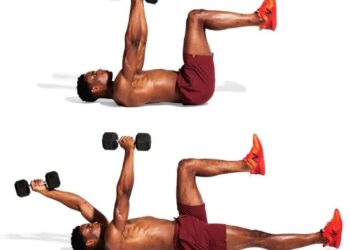
The 3-2-8 workout plan is a structured training approach focusing on compound exercises and specific rep ranges. The format denotes three sets of an exercise with two minutes of rest in between, aiming for eight repetitions per set. This routine is designed to maximize efficiency, cater to various fitness goals, and suit different fitness levels.
1. Principles and Benefits of the 3-2-8 Workout Routine
Principles
- Efficiency: The 3-2-8 workout routine is founded on the principle of optimizing efficiency during workout sessions. By structuring exercises into sets of three, aiming for eight repetitions per set with a two-minute rest interval, it maximizes the effectiveness of each exercise.
- Progressive Overload: The routine emphasizes the concept of progressive overload, gradually increasing the stress placed on the muscles over time. This progressive challenge is fundamental for muscle growth and strength development.
- Compound Exercises: Focusing on compound exercises is a core principle. These multi-joint movements engage multiple muscle groups simultaneously, promoting efficient muscle development and functional strength.
- Rest and Recovery: Adequate rest between sets is crucial for muscle recovery and optimal performance during subsequent sets. The two-minute rest intervals allow muscles to replenish energy stores and maintain performance.
- Adaptability: One of the key principles of the 3-2-8 routine is its adaptability. It can be tailored to suit different fitness levels, goals, and preferences, making it versatile and accessible for a wide range of individuals.
Benefits
- Efficient Time Management: The structured format of the 3-2-8 routine optimizes workout efficiency, allowing individuals to accomplish effective training within a relatively short period.
- Muscle Hypertrophy: The balance between sets, reps, and rest in this routine promotes muscle hypertrophy (muscle growth), making it an effective approach for individuals aiming to increase muscle size.
- Strength Development: The routine’s emphasis on moderate repetitions and progressive overload facilitates strength gains. It challenges muscles sufficiently to promote strength development over time.
- Versatility in Goals: Whether the aim is muscle building, strength enhancement, fat loss, or endurance improvement, the 3-2-8 routine can be customized and adapted to various fitness objectives.
- Reduced Risk of Overtraining: The structured rest intervals reduce the risk of overtraining by providing adequate recovery time between sets, helping prevent muscle fatigue and potential injury.
- Enhanced Focus and Intensity: By focusing on a specific set and repetition scheme, individuals are encouraged to maintain intensity throughout each set, fostering mental focus and engagement during workouts.
- Adaptability and Accessibility: The routine’s flexibility and adaptability make it accessible to individuals at different fitness levels, from beginners to advanced athletes.
The 3-2-8 workout routine is built upon fundamental principles aimed at optimizing workout efficiency, promoting muscle growth, and supporting various fitness goals. Its adaptability, emphasis on progressive overload, focus on compound exercises, and structured rest intervals offer a well-rounded approach to fitness, making it an attractive option for individuals seeking versatile and effective training methods.

2. Structuring the 3-2-8 Workout Routine
The 3-2-8 workout routine is structured around a specific set and repetition scheme coupled with adequate rest intervals. This structure aims to optimize muscle growth, strength development, and overall fitness gains.
Exercise Selection
- Compound Movements: Focus on compound exercises that engage multiple muscle groups simultaneously. Examples include squats, deadlifts, bench presses, pull-ups, and overhead presses.
- Variety and Balance: Incorporate a mix of exercises targeting different muscle groups to ensure a well-rounded workout routine.
Repetition Range
- Eight Repetitions: Aim for eight repetitions per set. This moderate rep range is effective for stimulating muscle hypertrophy while also promoting strength gains.
- Challenging Yet Manageable: The goal is to select a weight or resistance that challenges muscles within the designated rep range while maintaining proper form.
Rest Periods
- Two-Minute Rest: Allocate a rest period of approximately two minutes between sets. This rest duration allows for adequate muscle recovery while maintaining workout intensity.
- Balancing Rest and Intensity: The rest period should strike a balance between providing ample recovery time and keeping the workout pace sufficiently intense.
Setting Up a 3-2-8 Workout
- Warm-up: Begin with a dynamic warm-up to prepare muscles and increase blood flow, reducing the risk of injury.
- Exercise Execution: Perform the chosen exercises, adhering to the 3-set, 8-repetition format while maintaining proper technique and form.
- Rest Intervals: Allow two minutes of rest between each set to facilitate muscle recovery and prepare for the subsequent set.
- Progressive Overload: Aim to gradually increase weights or resistance as strength and endurance improve, ensuring a consistent challenge for muscles.
Customization and Progress Tracking
- Individual Adaptation: Adjust the workout routine based on individual fitness levels, goals, and preferences. Beginners might start with lighter weights, while experienced individuals might lift heavier or increase intensity.
- Tracking Progress: Maintain a workout log to monitor weights, repetitions, and overall progress. Tracking helps in gauging improvements and determining when to increase resistance.
Structuring the 3-2-8 workout routine involves careful exercise selection, adherence to a specific repetition range, and optimal rest periods between sets. The focus on compound movements, moderate rep range, and strategic rest intervals makes this routine effective for promoting muscle hypertrophy, strength gains, and overall fitness improvement. Customization based on individual capabilities and consistent tracking of progress are key elements in maximizing the effectiveness of the 3-2-8 workout routine.

3. Customizing the 3-2-8 Workout Routine for Specific Goals
The versatility of the 3-2-8 workout routine allows for customization to cater to various fitness objectives. By adjusting factors like weights, repetitions, rest intervals, and exercise variations, individuals can tailor this routine to align with specific goals.
Muscle Hypertrophy
- Rep Range: While the 3-2-8 format is already conducive to muscle growth, individuals focusing primarily on hypertrophy might consider higher rep ranges within the same structure, aiming for 10-12 repetitions per set.
- Increased Time Under Tension: Slowing down the lifting and lowering phases (eccentric and concentric) can increase time under tension, promoting muscle hypertrophy.
- Volume: Gradually increasing the number of sets or incorporating additional exercises targeting specific muscle groups can increase training volume, stimulating greater hypertrophy.
Strength Development
- Progressive Overload: Emphasize progressive overload by consistently increasing weights or resistance. Aim for challenging weights within the 3-2-8 framework, allowing muscles to adapt and grow stronger.
- Lower Rep Range: Adjusting towards a lower rep range, such as 4-6 repetitions per set, with heavier weights can promote strength gains by focusing on lifting maximal loads.
- Specific Strength Exercises: Incorporate exercises that specifically target strength development, such as powerlifting movements or heavier variations of compound exercises.
Fat Loss and Endurance
- Supersetting: Pairing exercises together or incorporating circuits with shorter rest periods between sets can elevate heart rate and increase calorie burn, beneficial for fat loss.
- Increased Intensity: Introducing high-intensity intervals or incorporating explosive movements like plyometrics can enhance cardiovascular endurance and facilitate fat loss.
- Focus on Full-Body Movements: Engage in full-body workouts utilizing compound movements to maximize calorie expenditure and metabolic rate during and after workouts.
Adaptation for Beginners vs. Advanced
- Beginners: Beginners may start with lighter weights, focusing on mastering proper form and technique. Gradually increasing weights as strength and proficiency improve ensures a safe progression.
- Advanced Athletes: Experienced individuals can lift heavier weights, challenge themselves with more complex variations of exercises, or introduce advanced training techniques within the 3-2-8 structure.
Flexibility and Individualization
- Listening to the Body: Adjustments should consider individual capabilities, limitations, and recovery capacity. Listening to the body and avoiding overexertion or injury is crucial.
- Consistency and Patience: Regardless of the specific goal, consistency in training, paired with patience and realistic expectations, is key to achieving long-term success.
Customizing the 3-2-8 workout routine involves adapting various parameters to suit specific fitness goals. Whether the objective is muscle hypertrophy, strength development, fat loss, or endurance improvement, tailoring the routine by adjusting rep ranges, exercise selections, rest intervals, and overall intensity can optimize results. Understanding individual needs, consistent effort, and gradual progression play pivotal roles in successfully customizing the 3-2-8 routine for diverse fitness objectives.

4. Sample Workout Plan for the 3-2-8 Routine
Creating a sample workout plan involves strategically selecting exercises, determining sets and repetitions, and planning rest intervals within the 3-2-8 structure. Here’s an example for a two-day split focusing on different muscle groups:
Day 1: Lower Body Emphasis
- Squats
- 3 sets x 8 reps
- Rest: 2 minutes between sets
- Deadlifts
- 3 sets x 8 reps
- Rest: 2 minutes between sets
- Lunges
- 3 sets x 8 reps (each leg)
- Rest: 2 minutes between sets
Day 2: Upper Body Emphasis
- Bench Press
- 3 sets x 8 reps
- Rest: 2 minutes between sets
- Pull-ups or Rows
- 3 sets x 8 reps
- Rest: 2 minutes between sets
- Overhead Press
- 3 sets x 8 reps
- Rest: 2 minutes between sets
Workout Execution
- Warm-up: Begin each session with a dynamic warm-up to prepare muscles and joints for the workout.
- Exercise Selection: Choose exercises that target major muscle groups while maintaining a balance between pushing and pulling movements.
- Repetition Range: Aim for eight repetitions per set, focusing on lifting controlled and challenging weights.
- Rest Intervals: Allow two minutes of rest between sets to ensure adequate recovery for subsequent sets while maintaining intensity.
- Progressive Overload: Over time, progressively increase weights or resistance to continue challenging muscles for growth and strength development.
Customization and Progress Tracking
- Customization: Individuals can customize the workout plan by incorporating variations, adjusting weights, or choosing alternative exercises based on individual preferences or goals.
- Progress Tracking: Maintain a workout log to track weights, repetitions, and any adjustments made. Monitoring progress helps in evaluating improvements and determining when to progress further.
Adaptation for Beginner vs. Advanced Levels
- Beginners: Beginners should start with lighter weights, focusing on mastering proper form and technique. Gradually increase weights as proficiency improves.
- Advanced Athletes: Advanced individuals may lift heavier weights or incorporate more challenging variations or advanced techniques within the 3-2-8 structure.
The sample workout plan provides a foundation for implementing the 3-2-8 routine. It includes exercises targeting specific muscle groups on different days, adhering to the 3 sets, 8 reps format with adequate rest intervals. Customization based on individual capabilities and goals, along with consistent progress tracking, is key to maximizing the effectiveness of the 3-2-8 workout routine for diverse fitness objectives.

5. Tracking Progress and Making Adjustments in the 3-2-8 Workout Routine
Tracking progress and making adjustments are integral aspects of any workout routine, including the 3-2-8 structure. This section focuses on methods for tracking progress and how to make necessary adjustments to optimize fitness gains.
Methods of Tracking Progress
- Workout Log: Maintaining a detailed workout log that includes exercise names, weights used, repetitions completed, and rest intervals. This log serves as a reference point to track improvements over time.
- Progress Photos or Measurements: Taking regular progress photos or measuring specific body parts can visually showcase changes that may not be immediately apparent on the scale or in the mirror.
- Performance Metrics: Keeping track of performance metrics such as strength gains, increased endurance, or improved exercise execution can provide valuable insights into progress.
Identifying Progress Indicators
- Strength Improvement: Progressive overload leading to increased weight lifted or additional repetitions performed signifies strength gains.
- Muscle Endurance: Improvement in the ability to perform more repetitions with the same weight can indicate enhanced muscle endurance.
- Physical Changes: Visible changes in muscle definition, reductions in body fat, or improvements in overall physique are indicators of progress.
Evaluating Progress and Making Adjustments
- Consistent Assessment: Regularly reviewing workout logs and progress indicators to assess overall progress and identify areas that require attention.
- Plateaus or Stagnation: Plateaus are common in fitness journeys. If progress stalls for an extended period, it might be time to reassess the routine.
- Adjusting Intensity: Increasing weights, adjusting repetition ranges, varying exercises, or altering rest intervals can help break through plateaus.
- Variations and Progression: Incorporating new exercises, implementing advanced variations, or modifying the workout structure can prevent staleness and stimulate new progress.
- Recovery and Rest: Sometimes, lack of progress could indicate inadequate recovery. Ensuring adequate sleep, managing stress, and allowing proper rest between workouts are crucial.
Adapting for Specific Goals
- Muscle Hypertrophy: For hypertrophy goals, tracking increased muscle pump or noticing enhanced muscle fullness during and after workouts can indicate progress.
- Strength Development: Tracking weight increases or progression towards lifting heavier weights with good form demonstrates strength improvements.
- Fat Loss: Monitoring changes in body composition, such as reductions in body fat percentage, waist measurements, or clothing fit, can reflect fat loss progress.
Consistency and Patience
- Setting Realistic Expectations: Fitness progress takes time. Consistency and patience are essential. It’s crucial to understand that results won’t always be immediate but will come with dedicated effort and time.
- Celebrating Milestones: Acknowledging and celebrating small victories along the way helps maintain motivation and a positive mindset.
Conclusion
The 3-2-8 workout routine offers a structured and versatile approach to training, catering to various fitness goals. By selecting suitable exercises, adhering to specific rep ranges, incorporating appropriate rest periods, and customizing for specific objectives, individuals can optimize their workouts for muscle growth, strength development, fat loss, or endurance improvement. Regularly tracking progress and adjusting the routine ensures continual improvement and supports a well-rounded fitness journey.
Source: Admin compiled from the Internet





















